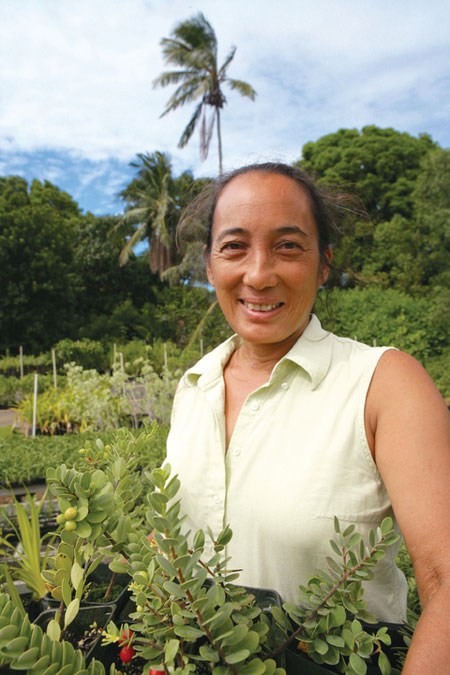 The indigenous plants that framed our photo of Ho‘olawa Farms’ Anna Palomino had a wide variety of uses—which Hawai‘i’s first people were adept at discovering. Our thanks to Anna for the following information:
The indigenous plants that framed our photo of Ho‘olawa Farms’ Anna Palomino had a wide variety of uses—which Hawai‘i’s first people were adept at discovering. Our thanks to Anna for the following information:
‘A‘ali‘i (Dodonaea viscose)
Hawaiians used the leaves of this shrub to heal wounds and treat insect bites, the colorful seed capsules for lei. A very hard wood, ‘a‘ali‘i was also used in housing construction.
Alula (Brighamia insignis)
Early Hawaiians ate this succulent perennial as a treatment for consumption and other disorders. Endemic and endangered, alula grows on rocky ledges along steep sea cliffs, and was historically found on the islands of Ni‘ihau and Kaua‘i. Its fragrant yellow flowers bloom September to November.
Hala (Pandanus tectorius)
Also known as screwpine, this distinctive-looking tree has thick aerial roots, and fruit that bears a striking resemblance to pineapple. Despite its odd appearance, Hawaiians found plenty of practical uses for hala, weaving mats, baskets and sails from its leaves, and eating the fruit in time of famine. Some legends say hala contributed to the origin of mankind.
Koa (Acacia koa)
Early Hawaiians carved canoes from these large, hardwood trees, and also used koa to make surfboards, paddles and house framing. Found on all the main islands, this endemic tree has the odd characteristic of producing two different kinds of leaves: juvenile leaves that look almost fernlike, and mature leaves that resemble a scythe.
Koki‘oke‘okeo (Hibiscus arnottianus)
A large shrub or small tree, koki‘oke‘okeo is endemic to the Ko‘olau and Wai‘anae mountain ranges of O‘ahu, and to Wailau Valley on Moloka‘i. Its large white flowers yield a sweet fragrance.
Loulu (Pritchardia spp)
Hawai‘i has nineteen endemic species of loulu, a palm tree with a single trunk and fan-shaped leaves. This particular one is endemic to East Maui. In old Hawai‘i, the leaf blades of the loulu were used for thatching, the wood for spears, and the seeds as food.
Ma‘o (Gossypium tomentosum)
Also known as Hawaiian cotton, ma‘o grows in dry, rocky coastal areas. Throughout the year, the plant produces bright yellow, hibiscus-like flowers, from which the Hawaiians made dye for their kapa. The flowers and seeds are used in lei.
‘Ohi‘a (Metrosideros polymorpha)
A tree that can vary considerably in flower color, leaf forms and growth habits, the ‘o‘hia is an important source of nectar for many native birds. In centuries past, its flowers and leaf buds were used as medicine. In the future, ‘o‘hia may be valued still more for its role in watershed protection.
Pili grass (Heteropogon contortus)
A clumping grass with attractive seed heads, pili is found in dry regions on all the major Hawaiian Islands, and was used for thatching.
U‘ulei (Osteomeles anthyllidifolia)
A member of the rose family, and indigenous to Hawai‘i, u‘ulei has a wide range of habitats and a variety of uses. Hawaiians fashioned the stems of this tough plant into fishing nets and valued the bark for its medicinal properties. U‘ulei also produces a fruit that was eaten in times of famine.





